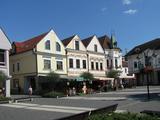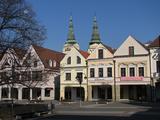Žilina Gallery
» Mesto Žilina » História a archeológia » Pamiatky – QR kódy » Pamiatky QR kódy II » 88 Meštiansky dom č. 4
3/4
88 Townhouse 4 (EN)

88 – Townhouse 4, Mariánske námestie č. 4
Turistická informačná tabuľka č. 88 s QR kódom na meštianskom dome na Mariánskom námestí č. 4(Foto: 23. 9. 2007)
The most famous butcher’s in Žilina was a butcher’s called "At Hrabovec’s", owned by Aloiz Hrabovec, a famous butcher from Žilina. The house and shop were named after him. Even after nationalisation and even now despite the building being used for different purposes, it is still called "At Hrabovec’s". Although it wasn’t the only butcher’s in town, it was the only one on present-day Mariánske Square. The butcher’s was one of the oldest trades in the town and was grouped together with other food trades, such as millers, bakers and brewers. Butchers occupied an important position in Žilina and after the drapers they had the second largest guild in town. Courtesy of the Book of Žilina we even know the name of the first butcher in Žilina – Andreas Fleischer (butcher) – who was also a member of the town council in the 15th century. The first records of the butchers’ guild date back to the 16th century. In the 17th century there were 25 masters in the guild and they worked exclusively for the town. Items belonging to the butchers’ guild from before 1558 have also been preserved. The butchers always worked with the soap makers who collected the bones for the manufacture of soap. The various guilds lent items to guilds in nearby towns, e.g. potters lend items to Trenčín (1584), Považská Bystrica (1659), and Kysucké Nové Mesto (1679). Varín received items from the butchers’ (1597), drapers’ (1669) and hatters’ guild (1661).
Meat was only produced for the town, but cattle were also sold in the surrounding villages. There was a single price and weight for all. Slaughter licenses were awarded on approval of the guild. Slaughter fees varied according to the season – on St. James’ day the cost was 2 pennies, but by the end of the carnival it was only a penny. Sick animals were taken to the municipal hospital, or to the town’s poor. One of the largest responsibilities that fell on the butchers was supplying the troops, especially during the anti-Habsburg uprisings. In 1663 they had to supply the troops with 210 old pounds (about 126 kg) of meat a day. However, in quiet times they often had such problems selling meat that the guild members had to consume it themselves. They defended themselves against foreign competition through the use of strict regulations, e.g. a master who sought business outside the town was deprived not only of the trade, but also of membership in the guild. Travelling butchers had the right to cut meat in town one day a week. Permits were issued for a charge of 15 florins to be paid into the guild’s coffers.
"At Hrabovec’s" was first owned, so far as we know, by Stephen Árvai in 1779. In the 19th century it belonged to Martin Vároš, and then his wife Zuzana, who married Martin Kastl. From 1828 on it was owned by their son Nicholas, a doctor in Trenčín. Then in 1850 Ján Felix and family (5 people) lived there. The house was inherited by Mikuláš Kastl’s grandson Anton Holz, who lived in Vienna and therefore sold it to Mária Gerometová-Fritzová in 1877. In 1891, the Gutwils family owned the house, until they left Žilina selling it to a well-known Žilina pharmacist, Gejza Hladký, for 60,000 crowns in 1910. The house was rebuilt in 1910 and then bought in 1922 for 600,000 crowns by Samuel Berger. In 1929 Ondrej Hrabovec became the owner and then left it to his children, Aloiz and dean Ondrej Hrabovec. In 1940, the back of the house, jutting out into Burianova medzierka was reconstructed and separated off from the house on the square. It belonged to Aloiz Hrabovský and Elena Hrabovská. In 1951 the house was nationalised and returned to descendants of the original owners in 1991.
There was a butcher’s at the front of the building until 1991, and the premises of VKUS and the Municipal National Committee - offices and an apartment – were located at the back. The medieval cellars and the rest of the stone entranceway are the most valuable part of the building. The remaining upper floors were completely reconstructed between 1910 and 1929 in eclectic style. The current design dates from 1997 by Ing. arch. Ľubomír Kružel. It has a new gable roof and gable facing onto the square and smaller dormer windows on the side.
Source: Mgr. Jozef Moravčík. Text prevzatý z webovej stránky TIK Žilina (kliknite): www.tikzilina.eu.
preberanie textov a obrázkov bez zvolenia autora je striktne zakázané
Site Map
Powered by PhpWebGallery
Site Map
Powered by PhpWebGallery


[0] Komentárov